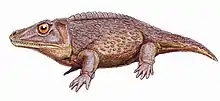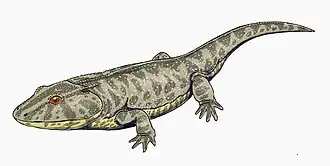| Trematosaurus Temporal range: Early Triassic | |
|---|---|
 | |
| T. brauni skull | |
| Scientific classification | |
| Domain: | Eukaryota |
| Kingdom: | Animalia |
| Phylum: | Chordata |
| Class: | Amphibia |
| Order: | †Temnospondyli |
| Suborder: | †Stereospondyli |
| Family: | †Trematosauridae |
| Subfamily: | †Trematosaurinae |
| Genus: | †Trematosaurus Burmeister, 1849 |
| Species | |
| |
Trematosaurus is an extinct genus of trematosaurid temnospondyl amphibian found in Germany and Russia.[1] It was first named by Hermann Burmeister in 1849 and the type species is Trematosaurus brauni.[1][2]
History of study
Trematosaurus was one of the first temnospondyls to be described. The type locality, called Merkel's Quarry, is in east-central Germany at Bernburg an der Saale within the Bausandstein (Olenekian) and was collected for several decades from the 1840s into the early 20th century, producing extensive cranial remains, although the majority of these are preserved as internal molds (steinkerns) or natural molds. The name Trematosaurus was in fact coined in 1842 by Carl von Braun, a frequent collector who used the Greek suffix trema ('hole') in reference to the pineal foramen to form the generic epithet, but as he provided no formal description, the name was not considered valid until the work of Burmeister,[2] who named the type species after Braun. Burmeister's work was largely reconstructive and frequently omitted references to which specimens were being described, and as a result, it remains unknown which specimens exactly were covered in his description. This was remedied by subsequent workers who provided specimen illustrations for material reposited at numerous museums across Europe.[3][4][5][6][7] However, the complete osteology and ontogeny of this taxon remained poorly documented until the work of Schoch (2019).[8]
Two other species were described from equivalent horizons in Thuringia, T. fuchsi and T. thuringiensis.[9][10] Trematosaurus fuchsi is widely regarded as a junior synonym of T. brauni, while T. thuringiensis is tentatively considered to be valid with the caveat that poor preservation of the single specimen may account for some of the purported differences.[11][1] Trematosaurus madagascariensis was synonymized with Tertremoides ambilobensis from the same horizon in Madagascar by Schoch & Milner (2000), with the species epithet of the former (named first) taking precedence by priority and the genus epithet of the latter taking precedence by distinction from Trematosaurus.[11] Trematosaurus sobeyi from Cynognathus Assemblage Zone of South Africa was placed in the novel genus Trematosuchus by Watson (1919).[6] Trematosaurus kannemeyeri from the same zone is thought to belong to Aphaneramma,[1][11] but other workers do not consider it to be diagnostic and thus to be invalid.[12][13] Trematosaurus yakovlevi from Russia was placed in the novel genus Thoosuchus by Efremov (1940).[14] Trematosaurus weidenbaumi was first removed to Thoosuchus and then placed in the novel genus Angusaurus by Getmanov (1989).[15] Various reports of Trematosaurus sp. from Russia belong to Inflectosaurus,[11] but Trematosaurus galae is a recently described Russian species that remains valid to date.[1]
Description

The overwhelming majority of specimens of T. brauni are partial to complete skulls, with 75 such specimens known (size range from 10.9 to 41 cm in length). Postcrania are restricted to the clavicle and interclavicle, two large plate-like elements of the pectoral girdle. In part, this relates to the occurrence of other large stereospondyls at the type locality such as the capitosaur Parotosuchus nasutus, but postcrania are generally scarce, which may be due to either collection bias or taphonomic bias. Therefore, all diagnostic features of T. brauni are based on the skull. Autapomorphies include (1) temporal sulcus of lateral line with two portions, (2) occipital sulcus continuous, (3) pre-orbital region slightly shorter than half skull length (0.43–0.49), and (4) interorbital distance wide (interorbital distance/ skull length: 0.15–0.2).[8] The description is based only on referred specimens, as no holotype was ever designated and the syntypes described by Burmeister cannot be identified based on the scant details of his description; however, because they may exist, either within public or private collections, no neotype designation is warranted at present. Trematosaurus galae differs from T. brauni in (1) presence of well-pronounced lacrimal and zygomatic flexures of canals of the lateral line, (2) connection of both branches of the temporal groove at the ossification center of the supratemporal, and (3) in the presence of a supplementary groove (sulcus buccalis transversus) on the squamosal.[1] The more questionably valid T. thuringiensis differs only in having larger orbits and a narrower skull table than the type species.[11]
Given the large sample size of T. brauni, its ontogeny can be characterized, exhibiting features such as decreased orbit size and skull width but not other features such as broadening of the interorbital region or increased preorbital length, which occur in other temnospondyls.[8] Observations of more fragmentary material of T. galae indicate that specifically the prenarial region and the postorbital regions become longer, along with increased development of other features such as the basioccipital and ornamentation on the parasphenoid replacing a shagreen of denticles.
Classification
Below is a cladogram from Steyer (2002) showing the phylogenetic relationships of trematosaurids:[16]
| Trematosauridae |
| |||||||||||||||||||||||||||||||||||||||||||||||||||||||||
References
- 1 2 3 4 5 6 I. V. Novikov (2010). "New data on trematosauroid labyrinthodonts of Eastern Europe: 2. Trematosaurus galae sp. nov.: Cranial morphology". Paleontological Journal. 44 (4): 457–467. Bibcode:2010PalJ...44..457N. doi:10.1134/S003103011004012X. S2CID 85353510.
- 1 2 Burmeister, Hermann (1849). Die Labyrinthodonten aus dem bunten Sandstein von Bernburg: zoologisch geschildert / von Hermann Burmeister. Berlin: G. Reimer. doi:10.5962/bhl.title.5493.
- ↑ Fraas, Eberhaard (1913). "Neue Labyrinthodonten aus der schwäbischen Trias". Palaeontographica. 60: 275–294.
- ↑ Drevermann, Friedrich E. (1914). "Über einen Schädel von Trematosaurus brauni Burmeister". Centralblatt für Mineralogie, Geologie und Paläontologie. 1914: 627–628.
- ↑ Drevermann, Friedrich E. (1920). "Über einen Schädel von Trematosaurus brauni Burmeister". Senckenbergiana. 2: 83–110.
- 1 2 Watson, David Meredith Seares (1919). "I. The structure, evolution and origin of the amphibia. - The "orders' rachitomi and stereospondyli". Philosophical Transactions of the Royal Society of London. Series B, Containing Papers of a Biological Character. 209 (360–371): 1–73. doi:10.1098/rstb.1920.0001. ISSN 0264-3960.
- ↑ von Huene, Friedrich (1921). "Über einen wohlerhaltenen Gaumen von Trematosaurus brauni". Centralblatt für Mineralogie, Geologie und Paläontologie. 1921: 502–504.
- 1 2 3 Schoch, Rainer R. (2019-05-24). "Osteology of the temnospondyl Trematosaurus brauni Burmeister, 1849 from the Middle Buntsandstein of Bernburg, Germany". Palaeodiversity. 12 (1): 41. doi:10.18476/pale.v12.a4. ISSN 1867-6294. S2CID 181970743.
- ↑ Seidlitz, Wilfred von. (1920). "Trematosaurus fuchsi, ein Labyrinthodont aus dem thüringischen Buntsandstein". Palaeontographica. 63: 87–96.
- ↑ Werneburg, Ralf (1993). "Trematosaurus (Amphibia) aus dem Mittleren Buntsandstein (Untertrias) von Thüringen". Er- öffentlichungen des Naturhistorischen Museums. 7/8: 17–29.
- 1 2 3 4 5 Schoch, Rainer R.; Milner, Andrew R. (2000). Handbuch der Paläoherpetologie Part 3B. Stereospondyli. Stuttgart: Verlag Dr. Friedrich Pfeil. pp. 1–220. ISBN 978-3-931516-26-0. OCLC 580976.
- ↑ Fortuny, Josep; Gastou, Stéphanie; Escuillié, François; Ranivoharimanana, Lovasoa; Steyer, J.-Sébastien (2017-06-29). "A new extreme longirostrine temnospondyl from the Triassic of Madagascar: phylogenetic and palaeobiogeographical implications for trematosaurids". Journal of Systematic Palaeontology. 16 (8): 675–688. doi:10.1080/14772019.2017.1335805. ISSN 1477-2019. S2CID 134191156.
- ↑ Hancox, P.J.; Neveling, J.; Rubidge, B.S. (2020-06-01). "Biostratigraphy of the Cynognathus Assemblage Zone (Beaufort Group, Karoo Supergroup), South Africa". South African Journal of Geology. 123 (2): 217–238. Bibcode:2020SAJG..123..217H. doi:10.25131/sajg.123.0016. ISSN 1996-8590. S2CID 225828531.
- ↑ Efremov, Ivan A. (1940). "Preliminary description of the new Permian and Triassic Tetrapoda from U.S.S.R.". Trudy Paleontologicheskogo Instituta (in Russian). 10: 1–140.
- ↑ Getmanov, S. N. (1989). "Triassic amphibians of the East European platform (family Benthosuchidae Efremov)". Trudy Paleontologicheskogo Instituta. 236: 1–102.
- ↑ Steyer, J. S. (2002). "The first articulated trematosaur 'amphibian' from the Lower Triassic of Madagascar: implications for the phylogeny of the group". Palaeontology. 45 (4): 771–793. Bibcode:2002Palgy..45..771S. doi:10.1111/1475-4983.00260. S2CID 83515233.













